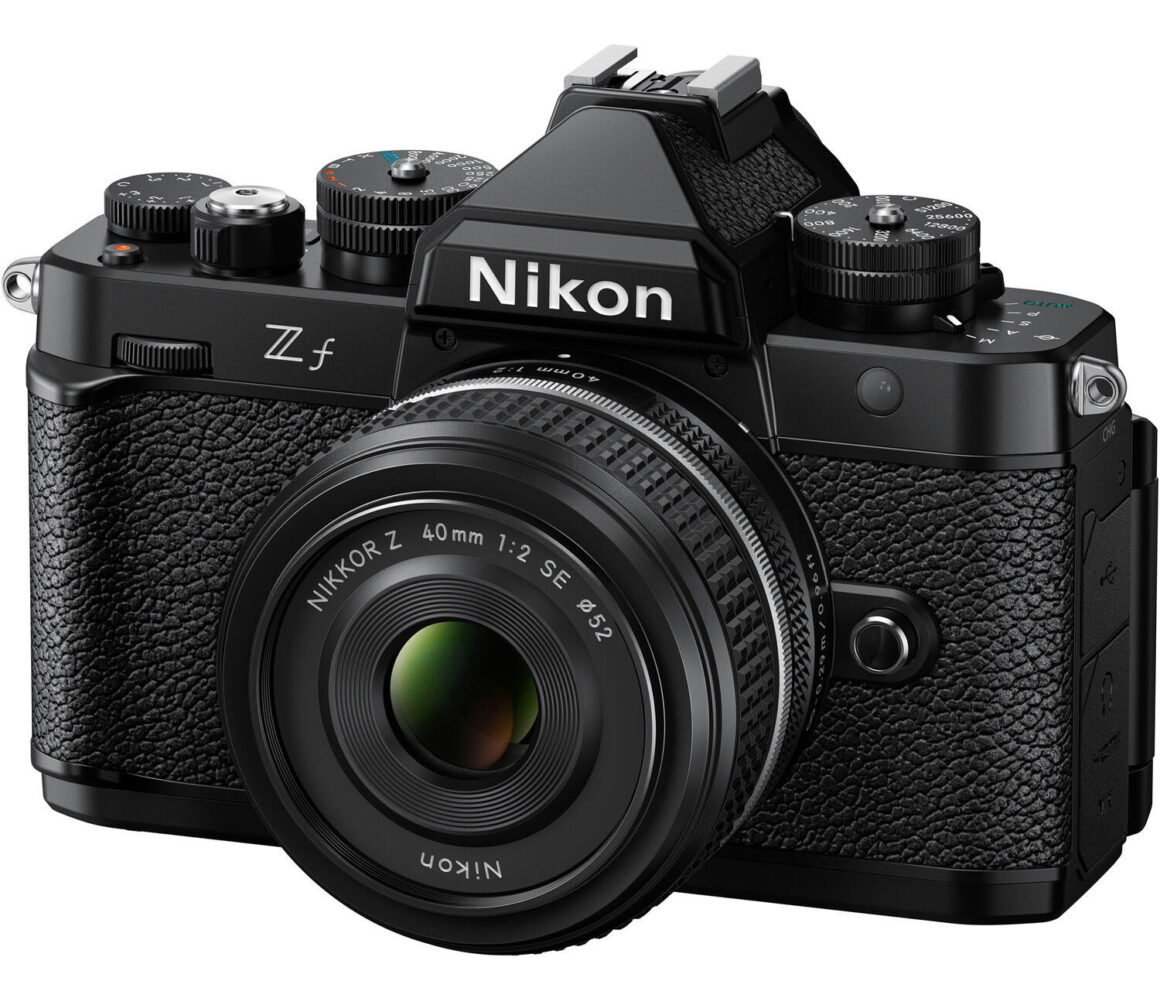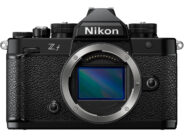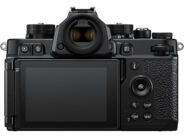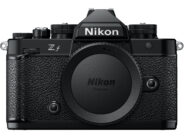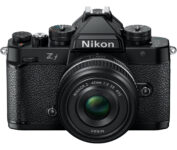Nikon Z f
35mm AF digital mirrorless camera
Specification
| Production details: | |
| Announced: | September 2023 |
| System: | ● Nikon Z (2018) |
| Format: | |
| Maximum format: | 35mm full frame |
| Imaging sensor: | 35.9 × 23.9mm CMOS sensor |
| Resolution: | 6048 × 4032 - 24 MP |
| Sensor-shift image stabilization: | Yes |
| Mount and Flange focal distance: | Nikon Z [16mm] |
| Shutter: | |
| Type: | Focal-plane |
| Model: | Electronically controlled |
| Speeds: | 900 - 1/8000 + B |
| Exposure: | |
| Exposure metering: | Through-the-lens (TTL), open-aperture |
| Exposure modes: | Programmed Auto |
| Aperture-priority Auto | |
| Shutter-priority Auto | |
| Manual | |
| Physical characteristics: | |
| Weight: | 630g |
| Dimensions: | 144x103x49mm |
Manufacturer description
TOKYO - Nikon Corporation (Nikon) is pleased to announce the release of the full-frame/FX-format Nikon Z f mirrorless camera for which the Nikon Z mount has been adopted.
The Z f is a mirrorless camera that balances a heritage design inspired by an iconic Nikon film camera with the latest in superior performance. It is equipped with a full-frame sensor and the same EXPEED 7 image-processing engine as the mirrorless flagship Nikon Z 9, enabling advanced still-image and video recording. In addition to realizing outstanding operability and a sophisticated design, the Z f features cutting-edge technologies, including exceptional AF and VR performance, that meet the needs of creators pursuing their individual forms and styles of expression.
Nikon will continue to pursue new dimensions in optical performance while meeting users' needs, contributing to the development of imaging culture, with the hope of expanding possibilities for imaging expression.
Primary features
1. A heritage design inspired by Nikon's iconic FM2 film camera
The magnesium-alloy body has an elegant glossy finish for a more authentic look and feel, and the dials, shutter-release button, and power switch are made of brass for a high-quality feel. It features a Nikon logo used in the 1970-80s as well as carved letters and numbers on the top of the camera. The passion of this heritage design is present in the details. As for the grip, consideration for a well-balanced look is maintained alongside stability when used with a full-frame lens. In addition, the feel of shutter-release button operation was given meticulous consideration. What's more, artificial leather with a refined look and texture has been adopted, the color of which users can choose to customize from one of six Premium Exterior color options*, enabling users to personalize their camera to further match their individual style.
2. A variety of functions that expand possibilities for imaging expression
In addition to the conventional [Monochrome] Picture Control, the Z f has been equipped with [Flat Monochrome] and [Deep Tone Monochrome] Picture Controls, each with unique tone characteristics. A dedicated [B&W] position has also been added to the photo/video selector (B&W photo mode), which enables immediate switching to black-and-white photo mode by simply rotating the selector, expanding users' possibilities for imaging expression. The camera is also equipped with a variety of other inspiring functions and features, including Creative Picture Controls, which enable more creative imaging expression, as well as Z f pixel-shift shooting, which supports the creation of high-resolution photos by merging multiple NEF (RAW) files, a feature that the Z f is the first to support.
3. Video performance that responds to diverse video production needs
The Z f supports in-camera, 10-bit H.265 recording, allowing users to record full-scale video with minimal peripheral devices, and without the need for an external recorder. It also supports recording of 4K UHD video using 6K oversampling*1, enabling creation of high-resolution video. The camera is also capable of recording up to approx. 125 min.*2 of 4K UHD/60p*3 video for scenes that require longer recording times, as well as being equipped with convenient video recording capabilities and functions inherited from the Z 9, including the ability to adjust ISO sensitivity in steps of 1/6 EV and display of a red frame during video recording. What's more, increased compatibility with products released by accessory manufacturers expands the accessory options available to users and contributes to comfortable video shooting.
*1 4K UHD/30p, 25p, 24p recording is only available at an image area setting of [FX].
*2 H.265 8-bit (MOV), [Auto temperature cutout]: [High], at 23°C/73°F, using EN-EL15c Rechargeable Li-ion Battery, and USB power supply. Use of the recommended memory card is advised.
*3 In DX image area.
4. Cutting-edge technologies for superior shooting performance
The Z f is equipped with the same EXPEED 7 image-processing engine as the Z 9. It supports superior tracking performance with subject detection, making it possible to maintain sharp focus on moving subjects. The same nine different types of subject detection supported on the Z 8 is available with both still-image and video recording. Furthermore, the low end of the AF detection range has been extended to -10 EV*1, enabling improved focusing in dark situations and expanding shooting possibilities. Additionally, the Z f achieves 5-axis in-camera vibration reduction (VR) that demonstrates performance equivalent to an 8.0-stop*2 increase in shutter speed, the best among Nikon Z series cameras, while also supporting improved electronic VR*3 that is useful with video recording. These improve the quality of images taken during hand-held shooting in dimly lit or dark indoor situations and with slower shutter speeds. The Z f is also the world's first camera*4 to support focus-point VR*5, which suppresses blur at the edges of the frame, even with compositions in which the subject is positioned at an extreme edge.
*1 Measured in photo mode at ISO 100 and a temperature of 20°C/68°F using single-servo AF (AF-S) and a lens with a maximum aperture of f/1.2.
*2 Measurement performed based on CIPA Standards in [Normal] VR mode using the NIKKOR Z 24-120mm f/4 S at the telephoto end.
*3 When electronic VR is enabled, the angle of view is equivalent to that of a lens with a focal length approximately 1.25x that of the lens being used.
*4 Among mirrorless cameras available as of September 20, 2023. Statement based on Nikon research.
*5 Not effective when a NIKKOR Z lens with built-in VR is used, AF-area mode is set to [Auto-area AF] and multiple focus points are displayed, or video recording is in progress.
5. Additional features
- The first Nikon camera to support video recording in shutter-priority auto mode. When this mode is selected, the user selects the shutter speed, and the camera adjusts the aperture.
- [3D-tracking] (photo mode only) and [Subject-tracking AF] (video mode only) have been added to AF-area mode options.
- Pixels used to create images and those used for AF achieve the optimal exposure for each process, making it easier to focus on the intended subject, even when that subject is silhouetted against backlighting or the scene is dimly lit or dark.
- The range of coverage and number of focus points used in auto-area AF mode have been increased for better focus acquisition performance with distant or moving subjects.
- Options available for custom wide-area AF mode have been increased, improving effectiveness for scenes with multiple subjects.
- Adoption of the EXPEED 7 image-processing engine reduces noise in flat portions of subjects and increases image quality.
- The first full-frame Z series mirrorless camera to be equipped with a vari-angle monitor.
- Vertical-orientation image playback and menu display during playback provide efficient support for vertical shooting.
- The first Z series camera to support Touch Fn for adjustment of camera settings while framing pictures in the viewfinder.
- The high processing ability of the EXPEED 7 image-processing engine enables High-Speed Frame Capture+ (C30), which achieves high-speed continuous shooting*1 at up to 30 fps*2.
- Equipped with a Pre-Release Capture function*3 capable of recording images buffered up to one second before the shutter-release button is fully pressed.
- Provides a skin softening function and a portrait impression balance function for users to better achieve the portraits they intended.
- Features a Rich Tone Portrait Picture Control that better captures details of the subject's complexion.
- Utilizes deep learning technology to identify the scene when capturing still images in auto shooting mode, realizing optimal exposure control in accordance with the scene.
- Supports the HEIF format, which records high-quality still images while reducing the amount of file data.
- Superior dust- and drip-resistance*4 enables worry-free shooting, even in harsh environments.
- Equipped with two memory card slots, one supporting SD cards and the other Micro SD cards.
- Dual coating has been adopted to protect the image sensor from dust.
- Supports the merging of NEF (RAW) images shot with pixel-shift shooting, with use of NX Studio Ver.1.5.0. The functions of Picture Control Utility 2 have been consolidated so that adjustment, application, and management of Picture Control can be completed within one app.
*1 Fixed at JPEG [L] and NORMAL. Use of the recommended memory card is advised.
*2 When the electronic shutter is used, rolling shutter distortion may occur according to subjects and shooting conditions.
*3 Pre-Release Capture is available only with shooting in [C30] High-Speed Frame Capture+ release mode, which supports continuous shooting at up to 30 fps.
*4 Thorough dust- and drip-resistance is not guaranteed in all situations or under all conditions.
